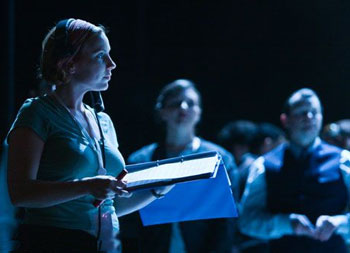Stage Manager
 Stage managers typically provide practical and organizational support to the director, actors, designers, stage crew and technicians throughout the production process. They also are the director's representative during performances, making sure that the production runs smoothly.
Stage managers typically provide practical and organizational support to the director, actors, designers, stage crew and technicians throughout the production process. They also are the director's representative during performances, making sure that the production runs smoothly.
The role of the stage manager is especially important to the director in rehearsals. Here the director and the stage manager work side by side, with the stage manager recording the director's decisions about blocking and notes for the actors, keeping track of logistical and scheduling details and communicating what goes on in rehearsals to the rest of the team. This enables the director to concentrate his or her full attention on directing.
Stage managers have several key responsibilities and tasks to perform in each phase of a production, including:
- scheduling and running rehearsals
- communicating the director's wishes to designers and crafts people
- coordinating the work of the stage crew
- calling cues and possibly actors' entrances during performance
- overseeing the entire show each time it is performed
In conjunction with the director, the stage manager determines the scheduling of all rehearsals and makes sure everyone involved is notified of rehearsal times, meetings, costume/wig fittings and coaching sessions. During the rehearsal phase, stage managers also:
- mark out the dimensions of the set on the floor of the rehearsal hall
- make sure rehearsal props and furnishings are available for the actors
- attend all rehearsals
- notify the designers and crafts people of changes made in rehearsal
In rehearsals the stage manager also records all blocking, plus all the light, sound and set change cues, in a master copy of the script called the prompt book. The information in the prompt book also allows the stage manager to run the technical rehearsals, calling each technical cue in turn to determine precisely how it needs to be timed to coordinate with the onstage action.
The stage manager and the technical director also work out a smooth and efficient plan for the stage crew to follow during set changes. Furniture and prop plans for complicated sets are drawn up by the stage manager and technical designer to show exactly where the furniture and props are to be positioned on stage at the beginning of each scene and sometimes in the wings.
Once the show opens, the director's work is essentially complete. Now it's the stage manager's job to make sure that every aspect of the production runs just as the director intended time after time, until the production closes.
Sample Job Description & Duties
Assistant Stage Manager
Often needed in larger productions, when the stage manager is out in the house, the ASM is often stationed just offstage to facilitate communication between the stage manager, crew and actors, as well as ensuring safety. The ASM often helps with complex set changes, quick changes offstage, or preparing the stage for performance.
More Resources
- Sample Contracts. A contract need not be complicated. It may be enough to list basic responsibilities, as can be seen in these downloadable contracts, provided in MS Word format by an AACT-member theatre. More contracts are available to AACT-member companies in our online Resource Library.
- Full job descriptions for many positions are available to companies who take part in AACTivity.
- Further Reading: What We Do - Working in the Theatre
, by Bo Metzler
- Job Listings: AACT's list of current employment opportunities posted by theatres around the country. These typically include job descriptions, which can be helpful in better understanding the position's purpose and requirements.
- Click here for more on the benefits of AACT membership.




